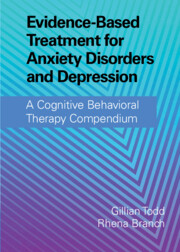 Evidence-Based Treatment for Anxiety Disorders and Depression
Evidence-Based Treatment for Anxiety Disorders and Depression from Part Four - Cognitive Behavioral Therapy for Depression
Published online by Cambridge University Press: 06 January 2022
This chapter describes evidence-based cognitive behavioral therapy (CBT) for the treatment of persistent depressive disorder (PDD) based on an randomized controlled trial conducted in the Nottingham Mood Disorders Service in collaboration with the University of Nottingham, UK. The chapter identifies three key challenges in the context of persistent depression. A case example is used to illustrate the treatment model and the implementation of a collaboratively derived psycho-bio-social formulation and its associated cognitive behavioral interventions.
To save this book to your Kindle, first ensure [email protected] is added to your Approved Personal Document E-mail List under your Personal Document Settings on the Manage Your Content and Devices page of your Amazon account. Then enter the ‘name’ part of your Kindle email address below. Find out more about saving to your Kindle.
Note you can select to save to either the @free.kindle.com or @kindle.com variations. ‘@free.kindle.com’ emails are free but can only be saved to your device when it is connected to wi-fi. ‘@kindle.com’ emails can be delivered even when you are not connected to wi-fi, but note that service fees apply.
Find out more about the Kindle Personal Document Service.
To save content items to your account, please confirm that you agree to abide by our usage policies. If this is the first time you use this feature, you will be asked to authorise Cambridge Core to connect with your account. Find out more about saving content to Dropbox.
To save content items to your account, please confirm that you agree to abide by our usage policies. If this is the first time you use this feature, you will be asked to authorise Cambridge Core to connect with your account. Find out more about saving content to Google Drive.